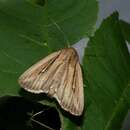Cyclicity
provided by University of Alberta Museums
In Alberta from mid June through early September, with the peak flight from mid July through early August.
- license
- cc-by-nc
- copyright
- University of Alberta Museums
Distribution
provided by University of Alberta Museums
Widespread in North America east of the mountains south to Florida, and from Newfoundland west to British Columbia. In Alberta commoides has been collected throughout the grasslands and parklands region north to the southern edge of the boreal forest (Edmonton) and west to the lower foothills.
- license
- cc-by-nc
- copyright
- University of Alberta Museums
General Description
provided by University of Alberta Museums
A medium-size (approx. 3.5 cm wingspan) moth with yellow-tan forewings with dark streaks and sooty-brown hindwings. There is a narrow black basal streak extending outward to a fine black discal dot, and a slightly thicker broken one along the bottom of the wing. The veins are thinly lined with white scales. The terminal area is slightly darker and has a number of short dark streaks and a series of indistinct dots indicating the postmedian line. The hindwings and all wing fringes are dull sooty brown. The sexes are similar, with females usually a bit darker. The large size, black streaks and dark hindwings will separate commoides from other Alberta Leucania species.
- license
- cc-by-nc
- copyright
- University of Alberta Museums
Habitat
provided by University of Alberta Museums
grasslands, parklands in boreal forest, foothills
- license
- cc-by-nc
- copyright
- University of Alberta Museums
Life Cycle
provided by University of Alberta Museums
The adults are nocturnal and come to light. There is a single annual brood; adults have been collected in Alberta from mid June through early September, with the peak flight from mid July through early August. The larval host of most Leucania, and probably commoides as well, is various species of grasses.
- license
- cc-by-nc
- copyright
- University of Alberta Museums
Trophic Strategy
provided by University of Alberta Museums
The larval host of most Leucania, and probably commoides as well, is various species of grasses.
- license
- cc-by-nc
- copyright
- University of Alberta Museums
Leucania commoides
provided by wikipedia EN
Leucania commoides, the comma wainscot or two-lined wainscot moth, is a species of cutworm or dart moth in the family Noctuidae.[1][2] It was described by Achille Guenée in 1852 and is found in North America.[2]
The MONA or Hodges number for Leucania commoides is 10447.[3][4]
References
- Lafontaine, J. Donald & Schmidt, B. Christian (2010). "Annotated check list of the Noctuoidea (Insecta, Lepidoptera) of North America north of Mexico". ZooKeys, vol. 40, 1-239.
- license
- cc-by-sa-3.0
- copyright
- Wikipedia authors and editors
Leucania commoides: Brief Summary
provided by wikipedia EN
Leucania commoides, the comma wainscot or two-lined wainscot moth, is a species of cutworm or dart moth in the family Noctuidae. It was described by Achille Guenée in 1852 and is found in North America.
The MONA or Hodges number for Leucania commoides is 10447.
- license
- cc-by-sa-3.0
- copyright
- Wikipedia authors and editors

